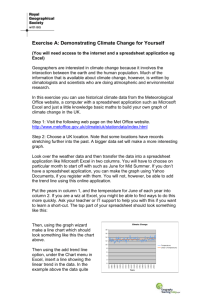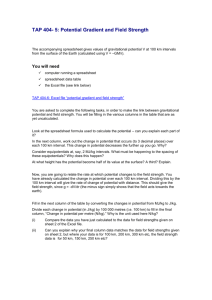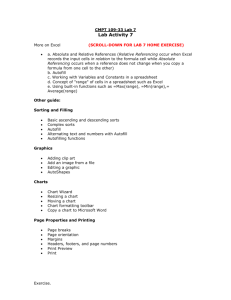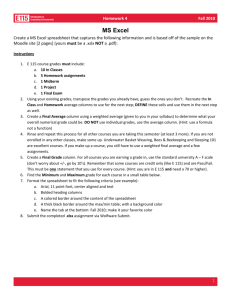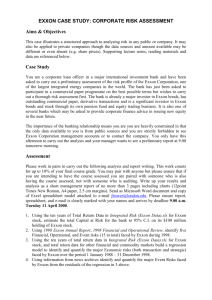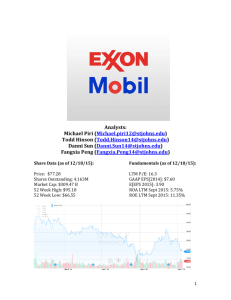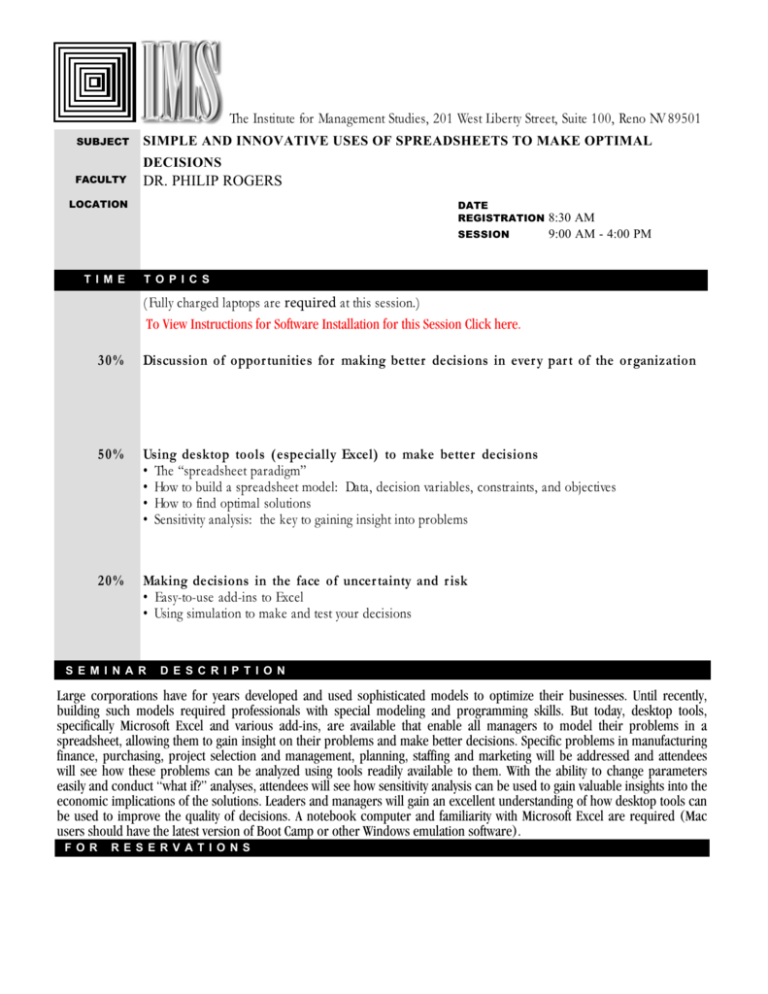
The Institute for Management Studies, 201 West Liberty Street, Suite 100, Reno NV 89501
SUBJECT
SIMPLE AND INNOVATIVE USES OF SPREADSHEETS TO MAKE OPTIMAL
FACULTY
DR. PHILIP ROGERS
DECISIONS
LOCATION
DATE
REGISTRATION
SESSION
T I M E
8:30 AM
9:00 AM - 4:00 PM
T O P I C S
(Fully charged laptops are required at this session.)
To View Instructions for Software Installation for this Session Click here.
30%
Discussion of opportunities for making better decisions in every part of the organization
50%
Using desktop tools (especially Excel) to make better decisions
• The “spreadsheet paradigm”
• How to build a spreadsheet model: Data, decision variables, constraints, and objectives
• How to find optimal solutions
• Sensitivity analysis: the key to gaining insight into problems
20%
Making decisions in the face of uncertainty and risk
• Easy-to-use add-ins to Excel
• Using simulation to make and test your decisions
S E M I N A R
D E S C R I P T I O N
Large corporations have for years developed and used sophisticated models to optimize their businesses. Until recently,
building such models required professionals with special modeling and programming skills. But today, desktop tools,
specifically Microsoft Excel and various add-ins, are available that enable all managers to model their problems in a
spreadsheet, allowing them to gain insight on their problems and make better decisions. Specific problems in manufacturing
finance, purchasing, project selection and management, planning, staffing and marketing will be addressed and attendees
will see how these problems can be analyzed using tools readily available to them. With the ability to change parameters
easily and conduct “what if?” analyses, attendees will see how sensitivity analysis can be used to gain valuable insights into the
economic implications of the solutions. Leaders and managers will gain an excellent understanding of how desktop tools can
be used to improve the quality of decisions. A notebook computer and familiarity with Microsoft Excel are required (Mac
users should have the latest version of Boot Camp or other Windows emulation software).
F O R
R E S E R V A T I O N S
THE KEY OBJECTIVES FOR THE DAY
Appreciate how spreadsheet modeling
can be used to:
• Solve complex business problems
• Maximize the use of your organization’s resources
• Improve your facility with Excel’s decision tools
Using spreadsheet modeling to make better
decisions
• The “spreadsheet paradigm”
• How to build a spreadsheet model: Data, decision
variables, constraints, objective
• Basic models and then optimization models using Excel’s
built-in add-in called Solver to find optimal solutions
• Sensitivity analysis: the key to gaining insight into
problems using the SolverTable add-in
• Using Palisade’s @Risk for handling problems that have
elements of risk and uncertainty
• The following are typical examples of the many types of
decisions that will be discussed….
Decision 3…
Scheduling multiple projects
• Suppose we have to complete multiple projects, each one
requiring a known level of resources (say workers) and a known
amount of time. How can we schedule the starting times for
each project to make sure we don’t exceed the number of
workers we have and yet finish all projects in the shortest
amount of time?
Decision 4…
Determining the best bid for a contract
• Suppose you are bidding on a contract where low bid wins.
You know your costs and can therefore determine the profit you
would make with any given bid IF you win the contest. How do
you rationalize your bidding strategy?
Decision 15…
• Cooper Construction has four teams, each team capable of
completing four jobs. Cooper management knows how long it
will take each team to do each of the four jobs (see below) and
wants to assign teams to jobs so that the total time to complete
all jobs is minimized. What should management do?
Decision 17…
• Fairfield Financial advises couples who are on the verge of
retiring. Joe and Betty Smith have gone to Fairfield to seek their
advice. They have $600,000 in after-tax savings and want to be
able to draw $70,000 a year from their savings and have their
savings last 20 years. What assumptions will Fairfield have to
make in order to advise the Smiths? Given these assumptions
are made, what will they tell the Smiths? Discuss and report.
F A C U L T Y
DR. PHILIP ROGERS is a clinical assistant professor in the Decision and Information Sciences
Department of the University of Houston where he teaches courses in statistics and executive
decision making. He received the university-wide Teaching Excellence Award for 2010-2011.
Before joining the faculty of U of H, Dr. Rogers spent 33 years at ExxonMobil where he developed
many sophisticated mathematical models that were used to optimize a wide variety of the
Corporation's business operations. Examples include competitive bidding strategies, scheduling
of airport refueling operations, short-term borrowing strategies, optimization of worldwide
product manufacturing and distribution, and the structure of catastrophic loss insurance policies.
As Manager of Management Science for Exxon's affiliate in Australia, Dr. Rogers built the country's
preeminent Management Science group. In addition to multi-year assignments in London and
Brussels, he served as Coordinator of all of Exxon's worldwide Management Science activities. In
that capacity, he was responsible for the allocation of a large R&D budget, for the development of
Exxon's expert systems program, and for spreading throughout the Corporation the use of
analytical techniques for production scheduling and for handling problems with multiple criteria.
Dr. Rogers has also managed Treasury operations at Exxon's corporate headquarters and has
held several managerial positions in Information Systems in various Exxon locations. Dr. Rogers
received a B.S. in Mathematics from Rensselaer Polytechnic Institute and both an M.S. and Ph.D.
in Operations Research from the University of California at Berkeley, with minors in Statistics and
Mathematical Economics.
G U I D E
T O
SENIOR EXECUTIVE
(Pres, Exec & Sr. VP)
EXECUTIVE
(VP & General Mgr)
SENIOR MANAGER
(Div. & Reg. Mgrs)
MIDDLE MANAGER
& SUPERINTENDENTS
P A R T I C I P A N T
2
2
1
2
2
2
1
1
2
2
1
1
Admin Distrib Engr
APPLICABILITY
S E L E C T I O N
2
2
1
1
2
2
1
1
3
3
3
3
2
2
1
1
Finc
H.R. Legal Mktng
2
2
1
1
2
2
1
1
IT
Ops
2
2
1
1
2
2
1
1
Plng Pchsg
2
2
1
1
2
2
1
2
R&D
Sales
“1” indicates primary target audience
“2” indicates a good fit if the level of material is appropriate
“3” indicates (in the opinion of the Institute and faculty) limited applicability.
F O C U S
PRIMARY
PLANNING/ORGANIZING:
Dealing with Risk and Uncertainty, Optimal Allocation of Resources, Problem Identification,
Selecting and Organizing Information, Analysis, Evaluating Alternative Solutions
SECONDARY
EXECUTING/CONTROLLING/EVALUATING:
Decision Making, Cost Control, Meeting Schedules, Results Analysis, Evaluation
TERTIARY
L E V E L
LEADERSHIP DEVELOPMENT:
Adaptability, Creativeness, Decisiveness
Introductory
Intermediate
Copyright © 2011 Institute for Management Studies. World rights reserved.
Advanced
Visit us on the web at www.ims-online.com



